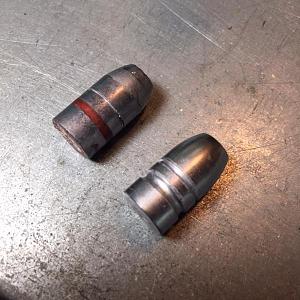I am working on a hunting load for my Ruger SBH using NOE 432-290-FNHP. I am using my alloy mix with BHN of 13 as measured with CabinTree. They weigh 278 and measure .434 as cast. A tight push-thru on the SBHS cylinder is .431, which is my sizing diameter using SAECO sizer with NOE's top-punch. From my pictures you can see they take quite a size-down. They require a deep size to include the nose else they won't chamber. My test loads are 20.5 of W296.
I have not yet shot any of these, but am concerned with the heavy sized and thus reduced lube groove, and even more about the uneven amount of 'push' out onto the bullet nose, thus creating what looks like 'out of round'. I see no way around this since I can't go much softer on the alloy to increase shrinkage. Maybe the visual on the nose won't have much / any effect?
Does anyone load this Boolit in 44 Mag? If so, how (alloy, size, load, results)?


|
   
   
|


|



 Reply With Quote
Reply With Quote



 DougGuy
DougGuy


















